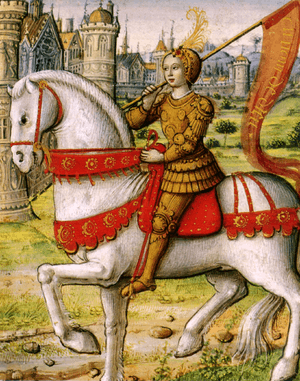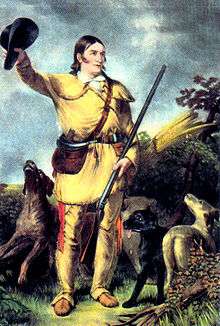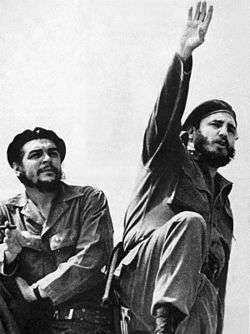Folk hero
A folk hero or national hero is a type of hero–real, fictional or mythological–with the sole salient characteristic being the imprinting of his or her name, personality and deeds in the popular consciousness of a people. This presence in the popular consciousness is evidenced by its historical frequency in folk songs, folk tales and other folklore; and its modern trope status in literature, art and films.

.jpg)


Although some folk heroes are historical public figures, many are not. The lives of folk heroes are generally fictional, their characteristics and deeds often exaggerated to mythic proportions.
The folk hero often begins life as a normal person, but is transformed into someone extraordinary by significant life events, often in response to social injustice, and sometimes in response to natural disasters.
One major category of folk hero is the defender of the common people against the oppression or corruption of the established power structure. Members of this category of folk hero often, but not necessarily, live outside the law in some way.
Historically documented folk heroes
- Alexander the Great - King of the Ancient Greek Kingdom of Macedon who created one of the largest empires of the ancient world
- Alfred the Great - English king of Wessex[1]
- Johnny Appleseed – United States, he introduced the apple to large parts of Ohio, Indiana, and Illinois
- Arminius – Germany, was a chieftain of the Cheruski who defeated the Roman army at the Battle of the Teutoburg Forest
- Dokubo-Asari - Nigeria, a political figure who currently fights against western oil companies in the Niger Delta
- Stepan Bandera - Ukraine, leader of the nationalist and independence movement of Ukraine
- Billy the Kid – United States, a 19th-century American frontier outlaw and gunman
- Black Hawk – Midwestern United States, a Sauk Indian warrior who resisted white settlement
- Bonnie and Clyde – United States, bank robbers who evaded retribution in the 1930s.
- Mohamed Bouazizi - Tunisian fruit vendor who immolated himself in protest of government mistreatment and sparked a successful revolution in that country and the Arab Spring
- Boudica - Great Britain, warrior queen who led an uprising against the Roman Empire in Britain
- Daniel Boone – United States, an American pioneer in the late 18th and early 19th centuries
- Brian Boru – Ireland, High King of Ireland who "drove the Danes out of Ireland" at the Battle of Clontarf
- John Brown – United States, attempted to lead a slave revolt in the south by raiding Harper's Ferry, helped spark the American Civil War[2]
- Calamity Jane – United States, a tough Wild West woman
- Kakutsa Cholokashvili – Anti-soviet guerilla fighter who led the August Uprising, national hero of Georgia.
- Joseph Cinqué – West African man of the Mende tribe, leader of the Amistad slave rebellion
- Gajah Mada - Indonesia, Unify the Southeast Asian archipelago of Nusantara in the 13th century for Majapahit
- Gregorio Cortez – Mexican-American folk hero[3]
- Davy Crockett – United States, an Indian-fighter and Congressman; died as a hero fighting in the Alamo[4]
- Nils Dacke – Sweden, leader of a 16th-century peasant revolt
- Zerai Deres – Eritrea, Eritrean-born man lionized for his act of vengeance against the Italian Fascists in Rome during an imperial celebration
- John Dillinger - United States, gangster and bank robber. Robbed dozens of banks, escaped from jail multiple times.
- Anton Docher - United States, Roman Catholic missionary and defender of the Native Americans in New Mexico, he fought for five years in the French colonial army
- Pier Gerlofs Donia – Frisia, legendary giant warrior, freedom fighter and leader of the Arumer Zwarte Hoop
- Ahmad Shah Durrani – The founder of the Afghan Durrani Empire
- Engelbrekt Engelbrektsson – Sweden, rebel and temporary regent in the 15th century
- Guy Fawkes – Roman Catholic restorationist from England who planned the Gunpowder Plot
- Mike Fink – United States, the toughest boatman on the Mississippi River and a rival of Davy Crockett[5]
- José Gaspar Rodríguez de Francia - First consul of Paraguay
- Eppelein von Gailingen – Germany, robber baron
- Giuseppe Garibaldi – Italy, general, he personally commanded and fought in many military campaigns that led eventually to the formation of a unified Italy.
- Geronimo – United States, Apache warrior, fought United States army for years defending his people and homeland
- Lazar of Serbia – Serbia, medieval Serbian ruler, who fought and perished at the Battle of Kosovo (1389).[6][7]
- Genghis Khan – Mongolian ruler of the Steppe during 13th century, founder of the Mongolian empire
- Owain Glyndŵr - Wales, nobleman who led a rebellion against the Kingdom of England
- Tomoe Gozen – Japan, female samurai warrior
- Husein Gradaščević – Bosnia, called "Dragon of Bosnia", led the resistance of Bosnians and uprising for autonomy of Bosnia against the Ottoman Empire
- Che Guevara – Argentine Marxist revolutionary, politician, author, physician, military theorist, and guerrilla leader.
- Nathan Hale – United States, a captain in the Continental Army during the American Revolutionary War
- Simo Häyhä – A legendary Finnish sharpshooter in the Winter War with 505 confirmed kills
- Hekimoğlu Turkish folk hero who led a campaign against feudal lords.
- Wild Bill Hickok – United States, lawman, gunfighter, gambler, scout, Civil War soldier, stage coach driver, performer, abolitionist
- Piet Hein – Netherlands, captured the Spanish treasure fleet
- Hone Heke – Māori chief who chopped down British flagpole three times
- Joe Hill – United States, union leader and songwriter wrongfully convicted of murder in 1915[8]
- Andreas Hofer – Austrian and particularly Tirolian hero who resisted the Bavarians and Napoleon
- Ishikawa Goemon – Japan, bandit hero notorious for robbing the rich and giving to the poor, though some accounts suggest he may have kept much of his ill-gotten gains. Before being boiled in oil, he saved his infant son at the cost of his own life.
- Jesse James – Wild West outlaw who supposedly robbed from the rich and gave to the poor (in reality his crimes only profited himself and his gang)[9]
- Juraj Jánošík – Slovak outlaw living in the Tatra mountains, defending Carpathian peasants from the tyranny of Hungarian landlords
- Casey Jones – United States, railroad engineer who remained in his locomotive and died in a collision while braking in order to save his passengers and sounding the whistle to warn the crew of the other train[10]
- Konstanty Kalinowski - Belarus, leader of Belarusian, Polish and Lithuanian national revival and the leader of the January Uprising
- Kaluaiko'olau – United States - Hawaiian who evaded deportation for leprosy by hiding in the Hawaiian rain forests[11]
- Karađorđe – Serbia, leader of the Serbian Revolution.[12]
- Ustym Karmaliuk – Ukrainian counterpart of Robin Hood, who led a peasant rebellion
- Ned Kelly – Australia, bushranger and leader of the Kelly Gang, most famous for crafting bullet proof armor
- Theodoros Kolokotronis - Greek general during the Greek War of Independence against the Ottoman Empire
- Tadeusz Kościuszko - Belarus/Poland - military leader
- Martin Krpan – Slovene smuggler, strongman
- Paul Kruger - South African Boer leader and President of the South African Republic (Transvaal)
- Lady Xian – China, warrior, politician, queen of the Hsien
- Rani Lakshmibai - Warrior Queen of Jhansi, fought and was martyred as the first revolutionary for Indian Independence
- Lam Sai-wing – China, martial artist and student of Wong Fei Hung
- Lampião – outlaw, leader of a Cangaço band in Northeast Brazil
- Lempira - Honduras, was a leader of the revolution against the Spaniards.
- Abraham Lincoln – President of the United States during the Civil War
- Nana Sahib - A leader in the First War of Indian Independence until his mysterious disappearance
- Francisco Solano López - President of Paraguay during the Paraguayan War
- Ned Ludd – Britain, leader of the Luddites in the 1810s
- Nelson Mandela - South Africa, anti-apartheid activist who became President on apartheid's end
- Louis Mandrin - France, bandit of the 18th century liked by the population because he attacked the tax collectors
- Prince Marko – Serbia, a medieval prince active during the fall of the Serbian Empire and Ottoman invasion, a hero in Serbian epic poetry.[13][14]
- Jack Mary Ann – a folk hero from the Wrexham area of north Wales whose fictionalised exploits continue to circulate in local folklore.
- James Morrow Walsh - Canada, a mountie who turned Sitting Bull and his peoples from enemies into friends in 1879.
- James Mckenzie – New Zealand, outlaw and inspiration to landless immigrants in early colonial New Zealand
- Joan of Arc- France, A peasant girl who led the French in the Hundred Years' War after she claimed saints told her it was God's will. Burned as a heretic she became a martyr, folk hero, and eventually a saint. She is now one of the patron saints of France.
- Juan Moreira - Legendary Argentine outlaw, famed as a skillful knife fighter he is considered one of the most important figures in Argentine history
- Maharana Pratap – India, a 16th-century Hindu ruler and Rajput hero
- Big Joe Mufferaw- Canada, a larger than life French Canadian woodsman took his life as a lumberjack in Ottawa.
- Miyamoto Musashi – Japan, a skilled swordsman, soldier, philosopher and author
- Miloš Obilić – Serbia, a knight who killed Ottoman Sultan Murad I at the Battle of Kosovo (1389), regarded a national hero.[15][16]
- Redmond O'Hanlon – Irish, rapparee of the 17th century
- Pemulwuy - Australia, an Aboriginal resistance leader.
- Philippe Petit – Tightrope artist who walked between the two towers of the World Trade Center
- Pazhassi Raja – India, fought against British Raj in south India (Kerala) with guerrilla war tactics
- Louis Riel – Canada, founder of Manitoba, led two rebellions against the Dominion of Canada
- Dorus Rijkers – the Netherlands, sailor and savior of over 500 men, women and children as the captain of a rescue-boat, in the late 19th century and the early 20th century
- Mir Chakar Rind - Pakistan, a 15th-century Baloch chieftain and folklore hero found in the Hani and Sheh Mureed tale
- Paul Revere - an American silversmith and a patriot in the American Revolution whose 'Midnight Ride' warned patriot rebels of the arrival of the British military troops.
- José Rizal – Philippines, a critic of the Spanish Colonizers, was gun-fired by his executioners in Bagumbayan (now Rizal Park)
- Rob Roy – Scotland, outlaw whose word was his bond
- Juan Santamaría – Costa Rican national hero
- Robert the Bruce - Scottish king who defeated the English invaders at the Battle of Bannockburn.
- Sarutobi Sasuke – Japan, incredibly acrobatic spy said to have been raised by monkeys and trained in the Ninja heartland of Iga and Koga provinces during the golden age of the Ninja.
- Laura Secord – Canada, heroine of the War of 1812
- Daniel Shays – An American farmer who led Shays' Rebellion in the late 18th century over debt and taxes
- Sitting Bull – shaman leader of the Hunkpapa Lakota
- Skanderbeg – Albanian national hero who led the resistance of Albanian people against the Ottoman Empire
- Soapy Smith – Infamous 19th-century Colorado and Alaska bad man.
- The Smith of Kochel – Germany, a well-known national hero, especially in Bavaria
- Spartacus – Thracean gladiator led the largest slave revolt against the Roman Republic
- Samuel Steele - Canada, an mountie who bring peace to Canada West, and the Yukon for laws and order. Preventing bloodshed between the First Nation peoples and the settler peoples of Canada.
- Tipu Sultan – Indian, a Muslim who fought and defeated the British in the Mysore wars
- Ivan Susanin – Russia, Russian peasant who saved the tsar in the early 17th century's Time of Troubles
- Tamanend – United States, an Indian chief who became the source of many folk legends during the American Revolutionary War
- Tecumseh – United States, Shawnee chief who formed a Native American confederacy to combat the United States
- Ten Tigers of Canton – China, group of ten fighters in southern China
- Yermak Timofeyevich – Russia, Russian Cossack leader who began the Russian conquest of Siberia
- Joseph Trumpeldor – Israel, leader of the Jewish forces at Tel Hai
- Nat Turner – America, Leader of Nat Turner's Rebellion (also known as the Southampton Insurrection), a slave rebellion that took place in Southampton County, Virginia in August 1831
- Dick Turpin – England, highwayman
- Vercingetorix - France, chief of the Arverni tribe, who united the Gauls in a revolt against Roman forces of Julius Caesar
- Viriathus – Portugal, the leader of the freedom fighters of the confederated Iberian tribes who resisted colonial Rome
- William Wallace – Scotland, knight who led a rebellion against England in the early 14th century
- George Washington - First President of the United States
- Wong Fei Hung – China, Chinese doctor, martial artist and revolutionary
- Huo Yuanjia – China, Chinese martial artist
- Yue Fei – China, general in the Jin–Song wars, his role in the war was exaggerated by later folk legends
- Jan Žižka – Czech knight, commander of Hussite armies in 15th century
- Pedro I of Brazil - Hero of Brazilian independence and hero of the Portuguese Civil War
Possibly apocryphal folk heroes
- King Arthur - Britain, Legendary British warlord.
- Cúchulainn - Ireland, folk legend and the pre-eminent hero of Ulaid in the Ulster Cycle
- Fionn mac Cumhaill - Ireland, warrior, leader of the Fianna. Primary figure in the Oisin cycle.
- Till Eulenspiegel or Tijl Uilenspiegel - Germany and the Low Countries, trickster and jester
- Fong Sai-Yuk - China, martial arts folk hero
- Grettir the Strong - Icelandic outlaw
- Hercules - Greece, strongman and demigod.
- Homer - Credited author of The Iliad and The Odyssey.
- Hung Hei-Gun - China, martial arts folk hero
- Nai Khanom Tom - Thailand, master of Muay Thai
- Miloš Obilić, Serbian knight, assassin of Ottoman sultan Murad I
- John Henry - United States, mighty steel-driving African-American
- Robin Hood - England, outlaw usually associated with the motto "Steal from the rich, give to the poor"
- Rummu Jüri - Estonia, outlaw who stole from the rich to give to the poor
- Siegfried - Germany, the legendary dragon-slaying hero in Nibelungenlied
- Twm Siôn Cati - Wales, robber and trickster nicknamed the Welsh Wizard
- Hua Mulan - China, heroine who disguised herself as a man in order to join an army
- William Tell - Switzerland, hunter began the rebellion against the Austrians
Folk heroes known to be fictional
- Beowulf - Scandinavia, legendary Geatish hero later turned king
- Pecos Bill - United States, giant cowboy who "tamed the Wild West"
- Paul Bunyan - United States, giant lumberjack of the North Woods
- Febold Feboldson - United States, farmer who could fight a drought
- Martín Fierro - Argentina, hero of the eponymous poem by Jose Hernandez
- Koba - Georgia, folk hero whose legend bears a resemblance to Robin Hood
- Joe Magarac - United States, steelworker made of steel
- Juan Bobo - Puerto Rico, trickster folk hero
- Alfred Bulltop Stormalong - United States, immense sailor whose ship was so big it scraped the moon
- Chen Zhen - China, martial artist who fought against Japanese aggression in pre-World War II China
- Momotarō - Japan, legendary figure from the Edo period who defeated a band of ogres
Real people with fictionalised lives
- El Santo - Real life Mexican wrestler, with heavy fictionalised adventures in movies and comic books
See also
| Look up folk hero in Wiktionary, the free dictionary. |
References
- ↑ Seal, 2001. Page 6.
- ↑ Seal, 2001. Page 34.
- ↑ Seal, 2001. Page 49.
- ↑ Seal, 2001. Page 50.
- ↑ Seal, 2001. Page 77.
- ↑ Czesław Robotycki (2003). Cultural Identity and Ethnicity in Central Europe: Proceedings of the International Conference on Ethnic and National Minorities in Central and Eastern Europe, Jagiellonian University, Cracow, May 11-16, 2000. UJ. p. 90. ISBN 978-83-233-1774-6.
- ↑ Charlie T. McCormick; Kim Kennedy White (2011). Folklore: An Encyclopedia of Beliefs, Customs, Tales, Music, and Art. ABC-CLIO. p. 809. ISBN 978-1-59884-241-8.
- ↑ Seal, 2001. Page 107.
- ↑ Seal, 2001. Page 125.
- ↑ Seal, 2001. Page 132.
- ↑ About Kaluaiko'olau Archived November 27, 2004, at the Wayback Machine.
- ↑ Danielle S. Sremac (1999). War of Words: Washington Tackles the Yugoslav Conflict. Greenwood Publishing Group. pp. 35–. ISBN 978-0-275-96609-6.
- ↑ Tanya Popovic (1988). Prince Marko: The Hero of South Slavic Epics. Syracuse University Press. ISBN 978-0-8156-2444-8.
- ↑ Velma Bourgeois Richmond (17 September 2014). Chivalric Stories as Children's Literature: Edwardian Retellings in Words and Pictures. McFarland. p. 182. ISBN 978-1-4766-1735-0.
- ↑ Tanya Popovic (1988). Prince Marko: The Hero of South Slavic Epics. Syracuse University Press. pp. 7–. ISBN 978-0-8156-2444-8.
- ↑ Wes Johnson (2007). Balkan Inferno: Betrayal, War and Intervention, 1990-2005. Enigma Books. p. 469. ISBN 978-1-929631-63-6.
Works cited
- Seal, Graham. Encyclopedia of Folk Heroes. ABC-CLIO, 2001.